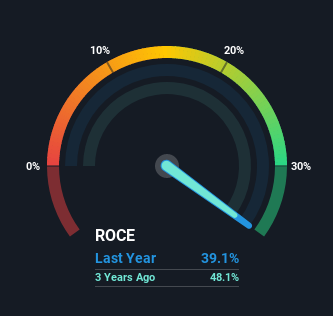There Are Reasons To Feel Uneasy About VST Industries' (NSE:VSTIND) Returns On Capital
Finding a business that has the potential to grow substantially is not easy, but it is possible if we look at a few key financial metrics. In a perfect world, we'd like to see a company investing more capital into its business and ideally the returns earned from that capital are also increasing. If you see this, it typically means it's a company with a great business model and plenty of profitable reinvestment opportunities. So when we looked at VST Industries (NSE:VSTIND), they do have a high ROCE, but we weren't exactly elated from how returns are trending.
What is Return On Capital Employed (ROCE)?
Just to clarify if you're unsure, ROCE is a metric for evaluating how much pre-tax income (in percentage terms) a company earns on the capital invested in its business. To calculate this metric for VST Industries, this is the formula:
Return on Capital Employed = Earnings Before Interest and Tax (EBIT) ÷ (Total Assets - Current Liabilities)
0.39 = ₹3.8b ÷ (₹15b - ₹5.2b) (Based on the trailing twelve months to June 2021).
Therefore, VST Industries has an ROCE of 39%. In absolute terms that's a great return and it's even better than the Tobacco industry average of 19%.
Check out our latest analysis for VST Industries

Historical performance is a great place to start when researching a stock so above you can see the gauge for VST Industries' ROCE against it's prior returns. If you want to delve into the historical earnings, revenue and cash flow of VST Industries, check out these free graphs here.
What Can We Tell From VST Industries' ROCE Trend?
In terms of VST Industries' historical ROCE movements, the trend isn't fantastic. While it's comforting that the ROCE is high, five years ago it was 59%. On the other hand, the company has been employing more capital without a corresponding improvement in sales in the last year, which could suggest these investments are longer term plays. It may take some time before the company starts to see any change in earnings from these investments.
On a related note, VST Industries has decreased its current liabilities to 35% of total assets. That could partly explain why the ROCE has dropped. Effectively this means their suppliers or short-term creditors are funding less of the business, which reduces some elements of risk. Some would claim this reduces the business' efficiency at generating ROCE since it is now funding more of the operations with its own money.
What We Can Learn From VST Industries' ROCE
In summary, VST Industries is reinvesting funds back into the business for growth but unfortunately it looks like sales haven't increased much just yet. Although the market must be expecting these trends to improve because the stock has gained 84% over the last five years. However, unless these underlying trends turn more positive, we wouldn't get our hopes up too high.
If you're still interested in VST Industries it's worth checking out our FREE intrinsic value approximation to see if it's trading at an attractive price in other respects.
VST Industries is not the only stock earning high returns. If you'd like to see more, check out our free list of companies earning high returns on equity with solid fundamentals.
New: Manage All Your Stock Portfolios in One Place
We've created the ultimate portfolio companion for stock investors, and it's free.
• Connect an unlimited number of Portfolios and see your total in one currency
• Be alerted to new Warning Signs or Risks via email or mobile
• Track the Fair Value of your stocks
This article by Simply Wall St is general in nature. We provide commentary based on historical data and analyst forecasts only using an unbiased methodology and our articles are not intended to be financial advice. It does not constitute a recommendation to buy or sell any stock, and does not take account of your objectives, or your financial situation. We aim to bring you long-term focused analysis driven by fundamental data. Note that our analysis may not factor in the latest price-sensitive company announcements or qualitative material. Simply Wall St has no position in any stocks mentioned.
Have feedback on this article? Concerned about the content? Get in touch with us directly. Alternatively, email editorial-team (at) simplywallst.com.
About NSEI:VSTIND
VST Industries
Engages in the manufacturing, trading, and marketing of cigarettes, tobacco, and tobacco products in India and internationally.
Flawless balance sheet average dividend payer.
Similar Companies
Market Insights
Community Narratives



